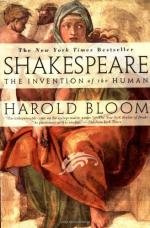
|
| Name: _________________________ | Period: ___________________ |
This test consists of 15 multiple choice questions and 5 short answer questions.
Multiple Choice Questions
1. Who does Bloom say influenced his view of Shakespeare?
(a) Nietzsche.
(b) Emerson.
(c) Frost.
(d) Eliot.
2. What gets better as the king's fate gets worse in "Richard II"?
(a) The king's insight.
(b) The king's heart.
(c) The king's patience.
(d) The king's poetry.
3. What quality do Faulconbridge and Hamlet have in common, according to Bloom?
(a) They are both paralyzed by doubts.
(b) They are both sons of kings.
(c) They are both larger than life.
(d) They are both unsuccessful contenders for thrones.
4. Who is Queen Mab, according to Bloom?
(a) The powerful mobs of London.
(b) Queen Elizabeth I.
(c) Mercutio's wife.
(d) The whore Mab.
5. What kinds of interpretations of "Midsummer Night's Dream" does Bloom say he resents?
(a) Interpretations that treat the play as a political drama.
(b) Interpretations that turn the play into a dark spectacle.
(c) Interpretations that over-sexualize the play.
(d) Interpretations that minimize the war of the sexes.
6. For whom is Shylock a predecessor, in Bloom's interpretation?
(a) Edmund in "King Lear".
(b) Macbeth in "Macbeth".
(c) Puck in "Midsummer Night's Dream".
(d) Caesar in "Julius Caesar".
7. How does Bloom characterize "Julius Caesar"?
(a) As the tragedy of the Senate.
(b) As the tragedy of Brutus.
(c) As a warning against ambition.
(d) As the tragedy of all politics.
8. Who does Proteus drive into exile?
(a) Valentine.
(b) Launce.
(c) Silvia.
(d) Julia.
9. Who was NOT a contemporary of Shakespeare's?
(a) Ben Jonson.
(b) John Fletcher.
(c) William Chaucer.
(d) Christopher Marlowe.
10. How does Bloom characterize Shylock?
(a) As a buffoon.
(b) As a comic villain.
(c) As a diminutive Barabas.
(d) As evil incarnate.
11. Viola duels with whom in "Twelfth Night"?
(a) Olivia.
(b) Malvolio.
(c) Orsini.
(d) Cesario.
12. What does Bloom reiterate about Christopher Marlowe?
(a) That he was older than Shakespeare.
(b) That he was murdered by English government agents.
(c) That he drank heavily while writing.
(d) That he was a youngest son.
13. How does Bloom characterize Caesar?
(a) A real person.
(b) A caricature.
(c) A sacrificial character.
(d) A larger-than-life figure.
14. Who does Viola end up with in "Twelfth Night"?
(a) Cesario.
(b) Orsini.
(c) Olivia.
(d) Malvolio.
15. How does Bloom characterize "Richard III"?
(a) Successful.
(b) Absurd.
(c) A spectacle.
(d) Improbable.
Short Answer Questions
1. What does Bloom say makes Caesar fascinating?
2. What are the men overcome by, in "Love's Labor's Lost"?
3. What do writers tend toward, after Shakespeare, according to Bloom?
4. Who saves "Two Gentlemen of Verona", in Bloom's opinion?
5. What did "Titus Andronicus" accomplish for Shakespeare, according to Bloom?
|
This section contains 418 words (approx. 2 pages at 300 words per page) |

|




